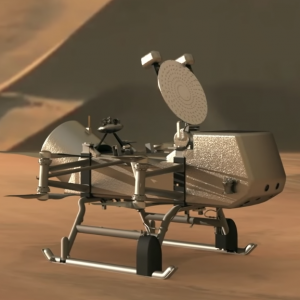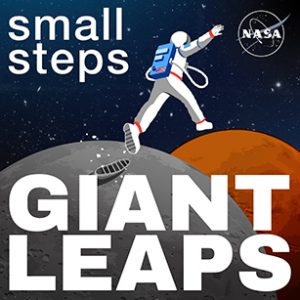Dragonfly Principal Investigator Zibi Turtle discusses NASA’s planned rotorcraft-lander mission to Titan.
Dragonfly is a Mars rover-size, drone-like vehicle that will explore the chemistry and habitability of Saturn’s largest moon. The fourth mission in NASA’s New Frontiers portfolio, Dragonfly is led by the Johns Hopkins Applied Physics Laboratory and planned for launch in 2027.
In this episode of Small Steps, Giant Leaps, you’ll learn about:
- Dragonfly science instruments
- The Dragonfly exploration strategy
- How lessons learned from previous missions are influencing the Dragonfly mission
Related Resources
Dragonfly to Explore the Icy, Exotic World of Titan
NASA Solar System Exploration – People: Elizabeth “Zibi” Turtle
APPEL Courses:
Science Mission & Systems: Design & Operations (APPEL-vSMSDO)
Science Mission & Systems: Design & Operations Lab (APPEL-vSMSDO-LAB)

Elizabeth Turtle
Credit: Johns Hopkins University Applied Physics Laboratory
Elizabeth “Zibi” Turtle is a planetary scientist at the Johns Hopkins Applied Physics Lab (APL) and the Principal Investigator of NASA’s Dragonfly New Frontiers mission to Titan. Turtle is also the Principal Investigator of the Europa Imaging System for the Europa Clipper mission. She was an associate of the imaging team on the Galileo mission, an associate of the imaging and RADAR teams on the Cassini mission, and a co-investigator of the camera on board the Lunar Reconnaissance Orbiter. Turtle has co-authored many scholarly articles about planetary impact features, surface and atmospheric processes, and planetary imaging and mapping. She joined the Johns Hopkins Applied Physics Laboratory in Laurel, Maryland in 2006. She previously worked at the University of Arizona in the Department of Planetary Sciences and at the Planetary Science Institute in Tucson, Arizona. Turtle has a bachelor’s in physics from the Massachusetts Institute of Technology and a doctorate in planetary science from the University of Arizona.
Transcript
Zibi Turtle: It will be the first long-duration in situ exploration of an ocean world in the outer solar system.
Dragonfly is designed to study Titan’s chemistry and the habitability of this extraterrestrial environment.
I also think it’s just going to be really spectacular to get aerial views of the surface of Titan as we’re flying above it from place to place. I think that’s just going to be thrilling to really feel like we’re there in the Titan environment with Dragonfly.
Deana Nunley (Host): Welcome to Episode 60 of Small Steps, Giant Leaps, a NASA APPEL Knowledge Services podcast where we tap into project experiences to share best practices, lessons learned and novel ideas.
I’m Deana Nunley.
Dragonfly is a NASA mission to send a rotorcraft-lander to explore Titan — Saturn’s largest moon and the second largest moon in our solar system. The mission is part of the agency’s New Frontiers Program and planned for launch in 2027.
Elizabeth ‘Zibi’ Turtle, a Planetary Scientist at Johns Hopkins Applied Physics Laboratory, is the Dragonfly Principal Investigator and leads the mission.
Zibi, thank you for joining us on the podcast.
Turtle: Oh, my pleasure.
Host: Let’s start with an overview of the Dragonfly mission.
Turtle: Dragonfly is a rotorcraft lander mission to Titan which is Saturn’s largest moon. It’s an icy satellite with a water-ice crust. And as for many of the moons in the outer solar system, it’s an ocean world which means it actually has a deep interior liquid water ocean. And Titan has a very unique combination of the ingredients that we know to be necessary for life as we understand it. It’s a very carbon-rich world. It’s had water available at the surface in its past and there’s sunlight. And so, we know these are all the ingredients necessary for life as we know it here on Earth, and this means that there is chemistry on Titan that’s very similar to the chemistry of the early Earth. And so, Dragonfly is designed to study Titan’s chemistry and the habitability of this extraterrestrial environment and to teach us about the chemistry that has occurred there and how far it has progressed. We don’t really know how chemistry took the step to biology here on Earth, and Titan has been doing these chemistry experiments for us. So, Dragonfly is designed to go pick up the results of those experiments.
Host: What is it that makes Titan so fascinating?
Turtle: There are so many things that make Titan a really fascinating place to explore. It’s the only moon in the solar system with an atmosphere. And in fact, the atmosphere is denser and higher pressure than our atmosphere here on Earth. So, it’s actually really pretty unique among the planets as well. It’s also very cold at Titan. It’s 94 Kelvin — is the surface temperature or negative 290 Fahrenheit.
So, we have very different conditions there and materials, and yet, it’s actually a really Earth-like place. The atmosphere is primarily nitrogen, like our atmosphere. The next major constituent of the atmosphere is methane and at the temperature and pressure conditions on Titan, nothing ends up playing the role that water does here on Earth. So, Titan actually has clouds in its atmosphere. There’s rain, and there are actually rivers and lakes and even seas of liquid methane on the surface. The surface is water ice. It’s a water-ice crust, whereas we have a silicate crust here on Earth. But nonetheless, the geology in many places is very familiar. I mentioned the rivers, lakes and seas. There are also dunes on the surface. There are organic dunes on Titan surface. And there may even be a hint of cryovolcanism, or cold volcanism. So, it’s a surprisingly familiar place geologically even though the conditions and the materials are so different from Earth.
The chemistry is particularly exciting. The carbon-rich molecules that are produced in the atmosphere fall out onto the surface. And so, there has been the opportunity for these very carbon-rich molecules to have mixed with liquid water for extended periods of time. There are a lot of places in the outer solar system that have water, but it’s much less common to have this complex carbon chemistry. And this may give us some insight into the chemistry that occurred very early on, on the Earth. So, it’s a very, very fascinating place from the perspective of astrobiology and prebiotic chemistry in particular.
Host: What are some of the firsts with Dragonfly?
Turtle: So, Dragonfly is a rotorcraft lander. It’s actually an octocopter, or an X8 octocopter technically. So, it has four pairs of two rotors, and it will fly its entire payload from place to place. It’s entirely self-contained. So, we communicate directly to Earth from the Dragonfly lander on the surface of Titan. It carries its entire suite of instruments with it as it explores different places on Titan. And it will be the first long-duration in situ exploration of an ocean world in the outer solar system. The nominal mission is a little over three years, and we may travel farther than a hundred miles exploring different areas on Titan.
Host: Wow. Why was flying a multirotor vehicle selected as the approach for this mission?
Turtle: We know that Titan has a really wide array of surface materials and places at the surface with different geologic histories. And we want to be able to study the materials in these different environments that have had different pasts, especially places where liquid water and organics may have mixed together. And we don’t have on Titan the same infrastructure we have at other places like Mars where there are multiple orbiters that can serve as relays, and that have been gathering detailed maps of the surface, images, surface topography for decades. So, we need to be entirely self-contained with Dragonfly. And flying means that we can explore a very wide array of different environments than we would be able to if we were to drive across the surface of Titan, for example. We can fly over the dunes and get to the next interdune area. And indeed over the lifetime of the mission, we will explore not only the dunes and interdunes at our first landing site but into deposits associated with an impact crater.
Flying also lets us scout out landing sites in advance. So, it gives us an opportunity to assess the potential future landing site from the perspective of hazards, as well as for the science measurements that we might be able to make there. So, for every future site, we’ll actually kind of go out, fly over it over at a low altitude, and take data, and then come back to our previously scouted landing site, and send the data back to Earth where we’ll I’m sure have very animated discussions about what we’re seeing and where we want to go next.
Host: What else feeds into the exploration strategy for the mission?
Turtle: As I mentioned, we’ll land in the dunes. Titan’s equatorial region has these vast sand seas of organic dunes that are really fascinating in and of themselves. And in this area, there are different materials easily accessible in very close proximity, within a few kilometers or just a mile or two of different materials because the dunes are made of an organic sand, and the interdune areas, the wide flat areas between these dunes, often have a water-ice component. And so, within very close proximity to our landing site, we’ll be able to make measurements of the different materials there. And then we’ll traverse across the dunes into deposits associated with an impact crater where the impact melt generated by the energy of the impact event will have provided an opportunity for liquid water and the very carbon-rich molecules on the surface of Titan to have mixed perhaps for a very extended period of time.
Dragonfly has a suite of instruments, including a mass spectrometer. We have two drills that will be able to sample the surface material. We’ll actually just suck the material up like a vacuum cleaner because we can use Titan’s atmosphere to just pneumatically transfer the surface material into the mass spectrometer where we can make very detailed measurements of the composition and structure of the molecules that we find on the surface. We also have a Gamma-Ray and Neutron Spectrometer that allows us to measure the bulk elemental composition of the surface around the lander. And then we have a suite of sensors to measure atmospheric conditions. So, meteorological measurements, temperature, pressure, wind speed, and direction, et cetera. And we’ll have some geophysics sensors, including a seismometer that will be to listen for Titanquakes. And then, of course, we have a suite of cameras so we’ll be able to get imaging at different scales, and we’ll even be able to do aerial imaging as well as we fly over Titan’s surface.
Host: How have previous NASA missions blazed the trail for Dragonfly?
Turtle: There’s always lessons learned from any mission that can be applied to future missions. In particular, of course, NASA’s Cassini orbiter that did the first detailed mapping of Titan’s surface as well the long-term observations of Titan’s weather over its seasons. The Cassini mission was in orbit around Saturn for 13 years and it had 126 flybys of Titan. So, it’s a lot of great opportunities to observe Titan. This timescale is almost half of a Titan year so we got to watch the weather patterns over almost half a Titan year as well. So, that provided really valuable data for planning the Dragonfly mission.
The ESA Huygens Probe that the Cassini orbiter brought to Titan dropped off to descend down through Titan’s atmosphere and measure the different aspects of the atmosphere during its two-hour descent to the surface as well as sending us back the first image of the surface of Titan, of course, provides very important data for planning our observations and our exploration of Titan. One of the neat timing coincidences is actually that Dragonfly will arrive basically one Titan year after the Huygens Probe descent. So, we’ll actually know what the atmosphere is like at this time of year because we have those measurements from the Huygens Probe.
And then, of course, there’s also a lot we can learn from exploration and other parts of the solar system. The many Rover missions that have explored Mars provide so much information, so much experience about exploration strategies for mobile vehicles in situ, in the environment. And so, there’s a lot we can learn from that. And we’ve just been so excited to watch Ingenuity’s first flights on Mars and that’s just been wonderful. There’s so much we can take from each of these different types of missions, lessons both in terms of the technical development and testing of hardware, but also on the operational side and how we plan our strategy for exploring.
Host: Zibi, from a science perspective, how is the Dragonfly mission different from other planetary science missions you’ve been involved with?
Turtle: On a personal level, most of the missions that I’ve been involved with have been orbiters, right? So, the observations have been remote sensing very remotely from during flybys or in orbit around planetary objects. So, the in situ exploration where you’re down in the environment, we’ll be down in the Titan environment, living in the Titan environment completely embedded is very different. And it’s a very different strategy for planning observation sequences and making decisions about where to go next. There’s always something new beyond the next horizon, but there are also lots of questions you want to answer in the location you are, and so there’s that kind of tension between staying and getting more in-depth information and traveling further to see what’s beyond the horizon.
Host: Flying a robotic rotorcraft over the dunes of an alien moon sounds much like science fiction. As Dragonfly PI, what gets you most excited about this mission?
Turtle: There’s so many things about this mission that are just thrilling. From a scientific perspective, I’m really excited about the synergistic science we’ll be able to do. We’ll be able to make very detailed measurements of the chemistry of different materials on Titan, materials that have had very different histories and sources. But we’ll be able to put that into the context of the Titan environment in terms of the atmosphere and how materials are transported by the atmosphere, in terms of the geology and how materials have had the opportunity to mix with each other at different types of locations over Titan’s history, as well as the context of potentially even Titan’s interior where we’re really able to listen for Titanquakes to see how seismically active Titan is. So, I’m really excited about how we’ll be able to kind of get the complete picture of this area on Titan.
I also think it’s just going to be really spectacular to get aerial views of the surface of Titan as we’re flying above it from place to place. I think that’s just going to be thrilling to really feel like we’re there in the Titan environment with Dragonfly. But also, planetary missions are a team sport really. Right? There are already hundreds of people working on this mission. And so, it’s really exciting to think about the mid-2030s when we’ll be exploring Titan. But on a day-to-day basis now it’s also a lot of fun, right? There’s a lot of hard work. There’s a lot of design work going on now. We’re in our preliminary design phase. There’s a lot of testing. We’re already doing testing of different components in a Titan-like chamber here at APL. And so, I just have a lot of excitement for the journey too, for each of the steps of the mission development and how we eventually get to Titan to explore there.
Host: We look forward to watching your next steps and seeing this journey as you prepare for the Dragonfly mission. Zibi, thank you so much for joining us today on the podcast.
Turtle: Oh, thank you very much. It’s been great talking with you about Dragonfly and Titan.
Host: Do you have any closing thoughts?
Turtle: Yeah, actually. Going back to the aspect of the team, one of the things about planetary missions is that the teams need all sorts of different expertise, right? And we’re used to thinking about the engineers and the scientists, but missions really involve pretty much every discipline you can think of. And of course, there’s an immense amount of management expertise that is needed to coordinate all of the different activities in the team that is spread globally, doing all of the design work and the different testing. And then even all of the people who do the artwork and graphics, and things like that. And we even are working very closely with people developing augmented and virtual reality tools to use both in the building of the lander itself as well as to be used as tools when we’re exploring Titan. And so, one of the other things that really excites me about the mission is getting to see all of these different pieces come together and just working with this incredible team.
Host: You can learn more about the mission in this episode’s Related Resources on our website at appel.nasa.gov/podcast. Zibi’s bio and a transcript of today’s show are also available.
For more information and interviews about what else is happening at NASA, we encourage you to check out other NASA podcasts at nasa.gov/podcasts.
As always, thanks for listening to Small Steps, Giant Leaps.







